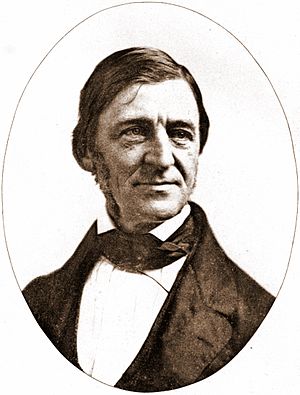 We continue with the third chapter from the The Power of Nonviolence: Writings by Advocates of Peace This week we discuss the third chapter of the book which is an excerpt from Ralph Waldo Emerson‘s essay entitled War. This chapter is in the Pre-Twentieth Century section of the book . Last week we discussed an excerpt from a 1693 essay by William Penn entitled Essay Towards the Present and Future Peace of Europe.
We continue with the third chapter from the The Power of Nonviolence: Writings by Advocates of Peace This week we discuss the third chapter of the book which is an excerpt from Ralph Waldo Emerson‘s essay entitled War. This chapter is in the Pre-Twentieth Century section of the book . Last week we discussed an excerpt from a 1693 essay by William Penn entitled Essay Towards the Present and Future Peace of Europe.
Shall it be war, or shall it be peace?
The discussion in this chapter is, unfortunately, as modern as the Duke’s recent Facebook discussion with childhood schoolmates. The other participants in the discussion brought up every possible reason why the war they opposed is an acceptable course of action. The lesser evil. The corruption of money in politics. The current state of affairs. The Duke kept returning the discussion to the phrase that ends the selection from Emerson’s essay, and serves as this paragraph’s pull quote.
Emerson’s answer to these objections matches those recently put forth by the Duchess in response to the comment that the Occupy Wall Street demands are wonderful, but unreasonable. Emerson states that
There is no good now enjoyed by society that was not once as problematical and visionary as this.
This reminds me of the more modern quote from Irish playwright and political activist George Bernard Shaw:
The reasonable man adapts himself to the world; the unreasonable one persists in trying to adapt the world to himself. Therefore all progress depends on the unreasonable man.
Emerson starts from where we are by cataloging how his world (and ours) is filled to the brim with military paraphernalia. The Duke was struck by a recent conversation that showed how pervasive the military presence is in our society. It was explained to the Duke how this parent was attending a high band event at a neighboring school, and representatives of the Marine Corps band where tabling there to give information about military service to the children competing. The parent inquired how the Marines came to be there, and was informed that the band parents of the host school had invited them.
Emerson then explains how every enterprise — for good or ill — in this world had started as an idea before it became brick and mortar. He show how the military scoiety is created from human’s worst instinct, their fears:
They only serve as an index to show where man is now; what a bad, ungoverned temper he has; what an ugly neighbor he is; how his affections halt; how low his hope lies.
He then returns to the catalog of military works where a society has turned to love, or as Emerson says “with a tender kindness toward the souls of men.” In that peaceful society “the cannon would become streetposts” etc.
To reach that point, Emerson finds that man must move from his current state of being where “the man fights” through an intermediary stage where “he makes no offensive demonstration, but is alert to repel injury” His “highest stage” of pacifism includes the Christian reference of the person who “turns the other cheek.”
Emerson responds to the Reductio ad absurdum argument that every pacifist will be robbed and murdered because they have left themselves defenseless. He differentiates pacifism from passivity. That to renounce violence is not the same as to standard passively by and allow it to happen. On the contrary pacifism is a call to action. it requires the believer to speak out against violence. Emerson takes this one step further and describes a pacifist society where such violence would become unthinkable.
His second response is that no one faced with an extreme circumstance will predetermine the outcome. This reminds the Duke of his answer to the common question about what would you do to defeat the Nazis. The Duke usually reminds the questioner that World War II ended 65 years years, and asks the questioner if they are admitting that every war in between that time was senseless. The Duke states that he would be quite happy if those 65 years of wars had never been fought.
Emerson sees the path to a pacifist nation as running through individual inner change. He does not see that it can be legislated, or — as we said before — instituted by cowards. Emerson’s hopes aptly describe the movement at Liberty Park:
if the rising generation can be provoked to think it unworthy to nestle into every abomination of the past
______
Emerson was a 19th Century American essayist, lecturer, poet, and Transcendentalist movement leader. He is closely associated with his friend, fellow Transcendentalist and subject of next week’s review Henry David Thoreau. Transcendentalism was a very individualistic religious practice which depended on the individual’s institution to transcend the physical and sensual. Despite the hermetic-sounding nature of the belief system, it’s proponents were often very socially active as pacifists and abolitionists.
Related articles
- Power of Nonviolence Mighty Penn: Peace Book Chapter 2 of the Week 9/26/11
- Power of Nonviolence Buddhist Anger: Peace Book Chapter 1 of the Week 9/19/11
- Power of Nonviolence Zinn-troduction: Peace Book Chapter of the Week 9/12/11
- Thich Nhat Hanh Royal Comic Book of the Week: Monday 9/5/11



One thought on “Power of Nonviolence Emerson War: Peace Book Chapter 3 10/3/11”